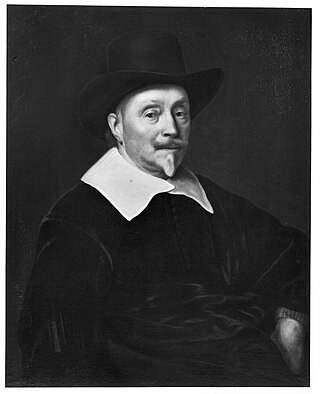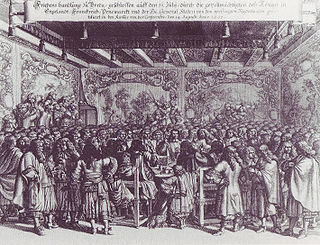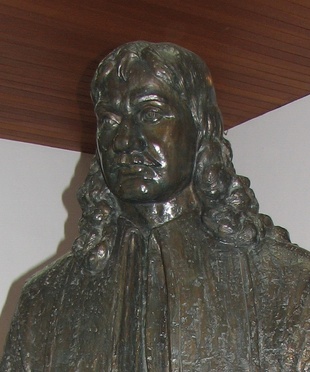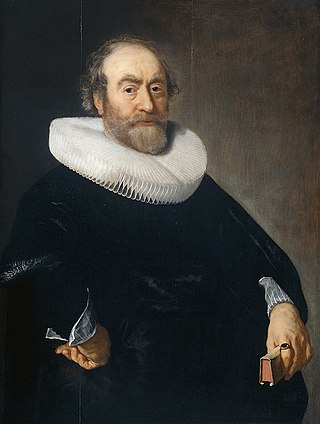
New Sweden was a colony of the Swedish Empire along the lower reaches of the Delaware River between 1638 and 1655 in present-day Delaware, Maryland, New Jersey, and Pennsylvania in the United States. Established during the Thirty Years' War when Sweden was a great power, New Sweden formed part of the Swedish efforts to colonize the Americas.

Samuel Blommaert was a Flemish/Dutch merchant and director of the Dutch West India Company from 1622 to 1629 and again from 1636 to 1642. In the latter period, he was a paid commissioner of Sweden in the Netherlands and he played a dubious but key role in Peter Minuit's expedition that led to the Swedish colonizing of New Sweden. For years Blommaert was involved in the copper trade and industry. In 1645 he was appointed for a third time as a manager of the WIC, being one of the main investors from the beginning.

The Delaware Colony, officially known as the three "Lower Counties on the Delaware", was a semiautonomous region of the proprietary Province of Pennsylvania and a de facto British colony in North America. Although not royally sanctioned, Delaware consisted of the three counties on the west bank of the Delaware River Bay. In the early 17th century, the area was inhabited by Lenape and possibly Assateague Native American Indian tribes. The first European settlers were Swedes, who established the colony of New Sweden at Fort Christina in present-day Wilmington, Delaware, in 1638. The Dutch captured the colony in 1655 and annexed it to New Netherland to the north. Great Britain subsequently took control of it from the Dutch in 1664. In 1682, William Penn, the Quaker proprietor of the Province of Pennsylvania to the north leased the three lower counties on the Delaware River from James, the Duke of York, who went on to become King James II.

The Peace of Breda, or Treaty of Breda was signed in the Dutch city of Breda, on 31 July 1667. It consisted of three separate treaties between England and each of its opponents in the Second Anglo-Dutch War: the Dutch Republic, France, and Denmark–Norway. It also included a separate Anglo-Dutch commercial agreement.

Kunta Kinteh Island, formerly called James Island and St Andrew's Island, is an island in the Gambia River, 30 km (19 mi) from the river mouth and near Juffureh in the Republic of the Gambia. Fort James is located on the island. It is less than 3.2 km from Albreda on the river's northern bank. As an important historical site in the West African slave trade, it is listed as a UNESCO World Heritage Site, together with related sites including a ruined Portuguese chapel and a colonial warehouse in Albreda, the Maurel Frères Building in Juffureh, and Fort Bullen and Six-Gun Battery, which are located at the mouth of the Gambia River.

Cape Coast Castle is one of about forty "slave castles", or large commercial forts, built on the Gold Coast of West Africa by European traders. It was originally a Portuguese "feitoria" or trading post, established in 1555, which they named Cabo Corso.
The Danish West India Company or Danish West India–Guinea Company was a Dano-Norwegian chartered company that operated out of the colonies in the Danish West Indies. It is estimated that 120,000 enslaved Africans were transported on the company's ships. Founded as the Danish Africa Company in 1659, it was incorporated into the Danish West India Company in 1671.

Swedish overseas colonies consisted of the overseas colonies controlled by Sweden. Sweden possessed overseas colonies from 1638 to 1663, in 1733 and from 1784 to 1878. Sweden possessed five colonies, four of which were short lived. The colonies spanned three continents: Africa, Asia and North America.

Frederick Coyett, born in Stockholm c. 1615 or 1620, buried in Amsterdam on 17 October 1687, was a Swedish nobleman and the last colonial governor for the Dutch colony of Formosa. He was the first Swede to travel to Japan and China and became the last governor of Dutch-occupied Taiwan (1656–1662).

Louis De Geer was a Walloon-Swedish entrepreneur, banker, industrialist and slave trader, who was part of the prominent De Geer family. A pioneer of foreign direct investment in the early modern period, De Geer is considered to be both the father of Swedish industry for introducing Walloon blast furnaces to Sweden and the father of the Swedish slave trade for pioneering Sweden's involvement in the Atlantic slave trade. Furnaces owned by De Geer produced cannons for German Protestants and the Dutch Navy and the Dutch East and West India Companies.

The Dutch Gold Coast or Dutch Guinea, officially Dutch possessions on the Coast of Guinea was a portion of contemporary Ghana that was gradually colonized by the Dutch, beginning in 1612. The Dutch began trading in the area around 1598, joining the Portuguese which had a trading post there since the late 1400s. Eventually, the Dutch Gold Coast became the most important Dutch colony in West Africa after Fort Elmina was captured from the Portuguese in 1637, but fell into disarray after the abolition of the slave trade in the early 19th century. On 6 April 1872, the Dutch Gold Coast was, in accordance with the Anglo-Dutch Treaties of 1870–71, ceded to the United Kingdom.

The Swedish Gold Coast was a colony of the Swedish Africa Company founded in 1650 by Hendrik Carloff on the Gulf of Guinea in present-day Ghana in Africa. Under foreign occupation for much of its existence, it disappeared for good in April 1663 when it became part of the Dutch Gold Coast.

Andries Bicker was a prominent burgomaster (mayor) of Amsterdam, politician and diplomat in the Dutch Republic. He was a member of the Bicker family, who governed the city of Amsterdam and with it the province of Holland for about half a century. At that time, the Republic was at the height of its power.

The Treaty of Butre between the Netherlands and Ahanta was signed at Butre, Dutch Gold Coast on 27 August 1656. The treaty regulated the jurisdiction of the Netherlands and the Dutch West India Company over the town of Butre and the surrounding country of Upper Ahanta, creating a Dutch protectorate over the area, and permitting the establishment of Fort Batenstein. The treaty lasted until the Dutch departure from the Gold Coast in April 1872.

Fort Batenstein was a fort and trading post established by the Dutch on the Gold Coast in 1656. It was situated near Butre. The fort was ceded with the entire Dutch Gold Coast to Britain in 1872.

Hendrik Carloff, Caerloff or Caarlof was an adventurer and slave trader active in the 17th century. Carloff began his career as a cabin boy but rose to become a commander and governor appointed by the Dutch West India Company and Danish or the Swedish Africa Company on the Gold Coast. Between 1676 and 1677, he was Governor of Tobago.

Jan Valckenburgh was a civil servant of the Dutch West India Company. Valckenburgh began as a simple assistant-trader, but managed to make career up to one of the highest ranks, that of Director-General of the Dutch Gold Coast, twice.

In September 1655, Dutch soldiers from New Netherland under the command of Peter Stuyvesant conquered the Delaware River colony of New Sweden. Under the terms of surrender the Swedish settlements were incorporated into the Dutch colony.

The Dano-Dutch War was a colonial conflict between the Danes and Dutch over the control of European fortifications on the Gold Coast. Denmark-Norway, assisted by England, defeated the Dutch in various places, although Michiel de Ruyter retaliated against the English by recapturing all forts but Cape Coast. This forced the Royal African Company into bankruptcy, which started the Second Anglo-Dutch War.


















